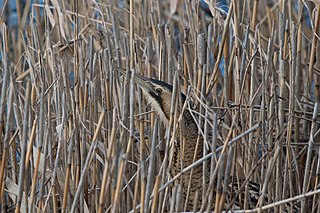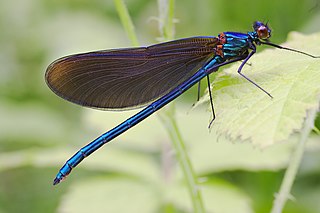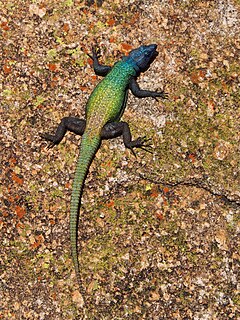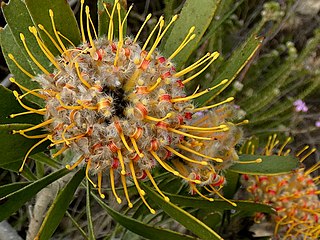
The palmate newt is a species of newt found in Western Europe, from Great Britain to the northern Iberian peninsula. It is 5–9.5 cm (2.0–3.7 in) long and olive or brown with some dark spots. The underside is yellow to orange, and the throat, unlike in the similar smooth newt, always unspotted. A dark stripe runs along the head and through the eyes. Breeding males develop a distinct filament on the end of their tail, strongly webbed hind feet, and a low, smooth crest on their back.

The Eurasian bittern or great bittern is a wading bird in the bittern subfamily (Botaurinae) of the heron family Ardeidae. There are two subspecies, the northern race breeding in parts of Europe and across the Palearctic, as well as on the northern coast of Africa, while the southern race is endemic to parts of southern Africa. It is a secretive bird, seldom seen in the open as it prefers to skulk in reed beds and thick vegetation near water bodies. Its presence is apparent in the spring, when the booming call of the male during the breeding season can be heard. It feeds on fish, small mammals, fledgling birds, amphibians, crustaceans and insects.

The alpine salamander is a shiny black salamander found in the Alps from the Swiss-French border at the western end of its range through Austria to the Dinaric Alps at the eastern end of its range, at altitudes above 700 m (2,300 ft). The western Alps are inhabited by a similar species, Lanza's alpine salamander, in only one small area. No differences in length are seen between the sexes and the sex ratio is 1:1. Their life expectancy is at least 10 years. Unlike other salamanders, whose larvae are developed in water, the alpine salamander is a fully terrestrial species. Capture-recapture methods suggest that the species is very stationary; 12 m (39 ft) was the maximum observed distance travelled by one individual during the summer season. About 120 individuals per hectare were counted in most suitable areas with >2000 individuals/ha also observed, suggesting that this rather cryptic species is quite abundant.

The grove snail, brown-lipped snail or Lemon snail is a species of air-breathing land snail, a terrestrial pulmonate gastropod mollusc.

The small blue is a Palearctic butterfly in the family Lycaenidae. Despite its common name, it is not particularly blue. The male has some bluish suffusion at the base of its upper wings but is mostly dark brown like the female. The species can live in colonies of up to several hundred and in its caterpillar stage is cannibalistic.

Gambelia sila, commonly known as the blunt-nosed leopard lizard, is a species of lizard in the family Crotaphytidae. The species is endemic to southern California.

The Calopterygidae are a family of damselflies, in the suborder Zygoptera. They are commonly known as the broad-winged damselflies, demoiselles, or jewelwings. These rather large damselflies have wingspans of 50–80 mm and are often metallic-coloured. The family contains some 150 species.

The ringed kingfisher is a large, conspicuous and noisy kingfisher bird commonly found along the lower Rio Grande valley in southeasternmost Texas in the United States through Central America to Tierra del Fuego in South America.

The southern dwarf siren is a perennibranch salamander lacking hind legs. Found exclusively in Florida, it is one of two currently recognized species of dwarf sirens. Two subspecies are currently recognized; P. a. axanthus, the narrow-striped dwarf siren, and P. a. belli, the Everglades dwarf siren.

The blue dasher is a dragonfly of the skimmer family. It is the only species in the genus Pachydiplax. It is very common and widely distributed through North America and into the Bahamas.
Niceforonia dolops is a species of frog in the family Craugastoridae. It is found in the Andes of southern Colombia and northern Ecuador. Specifically, it is known from the Cordillera Oriental and Colombian Massif in Caquetá and Putumayo Departments, Colombia, and Napo Province, Ecuador. Common name Putumayo robber frog has been coined for it.

Telmatobius pefauri is a species of frog in the family Telmatobiidae. It is endemic to extreme northern Chile. It was already feared that this species is extinct, but recent research has suggested that the species is extant at several localities in the Arica y Parinacota Region, albeit at low numbers. Furthermore, morphological and genetic data suggest that Telmatobius zapahuirensis is a synonym of Telmatobius pefauri. Common name Arico water frog has been coined for this species.

Stereocyclops histrio is a species of frog in the family Microhylidae. It is endemic to the northeastern Bahia state of Brazil where it occurs in remnants of the Atlantic forest. After the holotype was collected in 1944, the species went unrecorded until a population was found in the Una Biological Reserve and its surroundings in 1999. It is now known from four locations. Common name Bahia yellow frog has been coined for it, perhaps in reference to the bright lemon yellow coloration of the holotype. It was the only species in the genus Hyophryne until 2012 when molecular data demonstrated that it is nested within Stereocyclops species.

The common flat lizard is a species of lizard in the Cordylidae family. This lizard has 9 subspecies, all living in southern Africa.

The Transvaal girdled lizard or Reichenow's spiny-tailed lizard is a very flattened girdled lizard from northeastern South Africa, Swaziland, and southeastern Botswana. It prefers rock outcrops in open grassland and feeds on small arthropods, especially beetles.

The twist-necked turtle also known as the flat-headed turtle, is distributed widely across northern South America. Twistoofnecked turtles have extremely flat shells that help them hide from predators under rocks and debris. When threatened, this turtle withdraws by twisting its head into its shell. P. platycephala is the only species of the genus Platemys and occurs in northern and central South America. Platemys platycephala means “flat turtle, flat-head” and accurately describes the structure of the head and shell. This species inhabits shallow creek beds and frequently forages on the floor of the Amazon rainforest for insects, amphibians, and mollusks. Camouflage, head and body shape, and advanced sexual anatomy allow this species of turtle to effectively populate much of South America. Mating occurs during rainy months (March–December) and egg deposit occurs during dry months (January–March). Males have been known to behave aggressively towards females during copulation by squirting water from nostrils and biting. A few genomic studies show mosaicism exists among populations of the twist-necked turtle in Surinam. In other words, diploid and triploid levels exist among individuals at this particular location. No threats have been reported for this species and the International Union for Conservation of Nature does not have a current listing. Lack of human consumption due to the species' small size and its wide range explain why scientists are not concerned about this turtle species.

Setina irrorella, the dew moth, is a moth of the family Erebidae. The species was first described by Carl Linnaeus in his 1758 10th edition of Systema Naturae. It is found in the Palearctic from Ireland, then through Europe and east to northern and central Asia to the Pacific Ocean. It is missing in the high north and parts of the Mediterranean region. It is found also in the limestone Alps up to 2,000 meters above sea level.

Andrena antoinei is an extinct species of mining bee in the family Andrenidae described from a single fossil found in a Late Oligocene lake in present-day France that existed in semi-arid conditions.

Leucospermum truncatum, commonly known as the limestone pincushion, is a shrub native to South Africa. The flowers are initially bright yellow but turn orange with time. Flowers can be found between August and December.

Mimetes saxatilis or limestone pagoda is an evergreen, upright, rarely branching shrub of 1–2¼ m high, assigned to the family Proteaceae. The approximately oval leaves are 3½–5 cm (1.4–2.0 in) long and 1½–3 cm (0.6–1.2 in) wide with a blunt, thickened, reddish tip or with three crowded teeth. It has cylinder-shaped inflorescences topped by a crest of green leaves, further consisting of heads with 12-22 individual bright yellow flowers, each in the axil of a flat, green leaf. It is an endemic species that is restricted to limestone outcrops in the Agulhas plains in the very south of the Western Cape province of South Africa. It is considered an endangered species. Flowering may occur between July and December, but is unreliable in its timing, dependent on sufficient moisture availability.



















